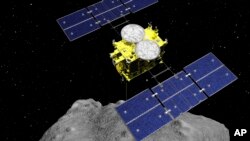A Japanese spacecraft has left a distant asteroid and started its return trip to Earth after successfully completing its mission.
The Japan Aerospace Exploration Agency, known as JAXA, said the Hayabusa2 spacecraft left its orbit around the asteroid Ryugu, Wednesday. The space rock is currently about 300 million kilometers from Earth.
Hayabusa 2’s mission was to gather soil samples and information that could provide clues to how the solar system formed, the country’s space agency said. The spacecraft is to bring those samples back so scientists can study them in a laboratory.
Workers at the command center stood up and cheered when JAXA project manager Yuichi Tsuda confirmed the departure.
The spacecraft captured pictures of Ryugu as it began its return trip and sent them back to Earth. The asteroid Ryugu, or Dragon Palace, is named after a sea-bottom castle in a traditional Japanese story. Hayabusa2 will continue its “farewell filming” of the asteroid for a few more days, JAXA said.
As the spacecraft travels away from the asteroid and toward Earth it will adjust its position. It will retreat about 65 kilometers from the asteroid and out of its the gravitational pull. After that, the asteroid will be out of sight of the spacecraft.
“It’s sad to say goodbye to Ryugu,” Tsuda told reporters. “Literally it has been at the center of our lives over the past 1½ years.”
The spacecraft will then start its main thrusters in early December to power it back to Earth. The return trip will take about one year.
“We expect Hayabusa2 will bring us new scientific insights,” Tsuda said. “Not only the data, but tangible samples will be in our hands.”
Hayabusa2 arrived at the 900-meter-long asteroid in June 2018. The spacecraft touched down on the extremely rocky asteroid two times and successfully collected information and soil.
The first touchdown took place in February. Hayabusa2 collected surface dust samples at the time. In July, it collected samples from beneath the surface of the asteroid after landing in a shallow hole that it had blasted. The operation was the first of its kind in the history of space exploration.
Scientists said they detected small amounts of carbon and organic material in the asteroid soil samples. “They will allow us to explore how carbon, organic matter and water are scattered around in the solar system, why they exist on Ryugu, how they are related to the Earth,” Tsuda said.
JAXA scientists believe the sub-surface samples contain valuable data because they are unaffected by space radiation and other forces. They believe the samples could tell more about the beginnings of the solar system 4.6 billion years ago.
Hayabusa2 is expected to reach Earth in late 2020 and drop a container holding the valuable samples in the Australian desert. Tsuda said landing the container at the targeted spot will require precision controls. Details are still being negotiated with the Australian government, he said.
After Hayabusa2 drops its container, the spacecraft may be used for another mission.
The spacecraft took more than three years to arrive at the asteroid. But the trip home is much shorter thanks to the current positions of Ryugu and Earth in their orbits.
Asteroids orbit the sun but are much smaller than planets or moons. They are believed to be among the oldest objects in the solar system and may help explain how Earth developed. They may even provide clues about the appearance of life.
I’m Mario Ritter Jr.
Mari Yamaguchi reported this story for the Associated Press. Mario Ritter Jr. adapted it for VOA Learning English. Kelly Jean Kelly was the editor.
________________________________________________________________
Words in This Story
mission –n. a task or job that must be done
sample –n. a small amount of something that gives information about the object it is taken from
thruster –n. part of a rocket engine that directs force
tangible –adj. something that can be touched and felt
allow –v. to permit, to let happen
precision –adj. the quality of being very exact, very accurate
We want to hear from you. Write to us in the Comments section, and visit our Facebook page.









